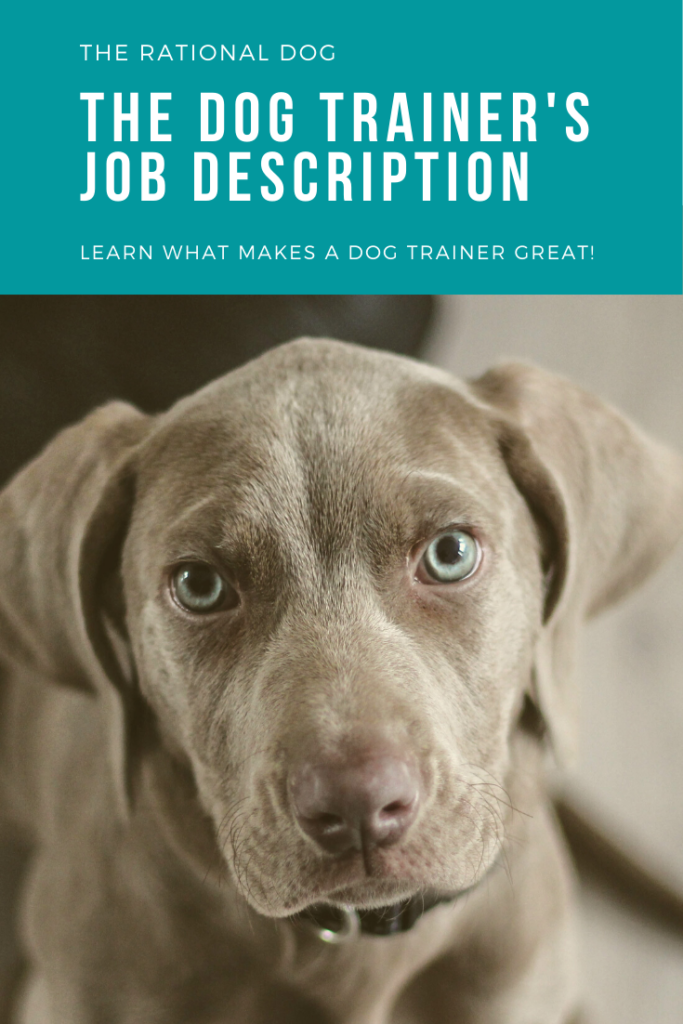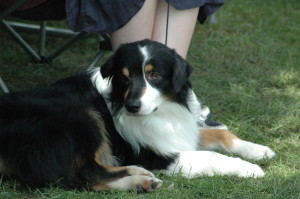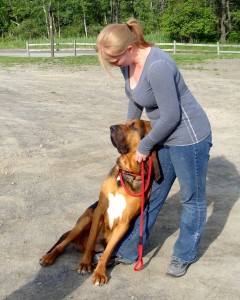Have you ever wondered about the life of a dog trainer? Not just a hobby dog trainer, but a professional dog trainer? I’ve run into a lot of misconceptions about what a professional trainer does, and I bet you’d be surprised about all that goes into this profession. There is so much more to it than just giving a dog a treat when he does what you want, or giving a correction when he does something wrong.
When you hire and work with a good professional dog trainer, you are working with someone who not only loves and understands dogs. You’re also working with someone who loves and understands people as well. That’s an important piece of the puzzle, and one that is often overlooked. Let’s take a quick look at what makes a dog trainer great at this job.
Looking for some ideas on training your dog? Click here to get access to our FREE mini-course!

Understanding different methodologies
When you decide that you’d like to become a professional anything, as a general rule, you begin to gather information and learn how to be competent, and then great, at your work. Teachers must complete a set amount of professional development hours each year to maintain their teaching certificates. Human resources workers must attend meetings to stay up to date on staff policies and how to manage tricky situations. So must dog trainers learn different methods of training, and do their best to stay up to date with new methods and trends in training.
This does not mean that every great trainer must be great at all training methods. Quite the opposite. In my opinion, it is better to become well-versed and highly proficient in one or two techniques than to be a Jack of all Trades in the training world. However, it is crucial that a good trainer understands how most training methods and techniques work, and can decide whether a particular methodology will be a good fit for the dog in front of them. For some, clicker training is exactly the type of work they need, and for others e-collar work is just the thing that will turn a dog around.
It is important for a professional trainer to be able to tell when the methods that they have mastered will be a great fit for the dogs that come to them, if they can use a variety of techniques that they have learned to teach this dog, or if the dog and owner would be better served by going to a different reputable dog trainer in the area. One of the wonderful things about living in the Dallas area is the large network of professional trainers in the area, who all specialize in a variety of training techniques! We are able to work together to help people find the best fit for their dog’s needs.
Training Dogs
This one seems pretty obvious. Training dogs is in the job description of a professional dog trainer. However, it’s definitely not as easy as it may seem. Beyond what we just talked about (deciding on the best techniques and methodologies to use with a particular dog), there are so many considerations. Every single dog is different. Each dog has a unique past, personality, likes, and dislikes. They have different motivators, and they have different reactions to corrections. They have different traits that have been bred into them over generations and generations of selective breeding, and they have varying attention spans. Even the basic intelligence of each dog is different.

Each dog is like a puzzle, especially at the beginning of a training program. Some are huge and complicated jigsaw puzzles, and some are simple “fit the shape” puzzles. But each one has their own unique needs, and it is a trainer’s job to learn these things about each dog that comes through their doors, and how to best serve them.
A trainer must also make adjustments for each specific dog on each particular day. A friend of mine often says that she can only train the dog that she has in front of her on that day. What this means is that dogs have great days, good days, and off days. Just like people do. A dog that could walk for a quarter mile with focused attention and perform every cue given flawlessly on Thursday, may be completely exhausted on Friday and only give you 10% of their abilities. A trainer has to adjust their expectations in every session with every dog, so that your dog does not burn out and begin to dread the training process.
When you do a training program, whether it’s a class, an in-home program, or a board and train program, your trainer will build a relationship with your dog. This takes extensive knowledge in understanding dogs. Trainers must know how dogs communicate with each other, and how a human can best replicate that to make a dog feel secure and safe during the training process. A trainer must understand how much pressure to put on a dog, and when to back off so that they can still have a successful training session.
And, of course, a trainer must know how to teach a dog the behaviors and cues that they need to know in order to reach the goals that their owners may have for them. It’s all well and good to be able to understand and build relationships with dogs (this is most of a trainer’s work, actually), but the most obvious part of dog training is being able to teach a dog to reliably respond to commands. No matter what methodology you subscribe to, or the mishmash of techniques that you use, it’s crucial to be able to actually deliver on the promises of a dog that waits at the door and greets guests politely.

Teaching People
Teaching a dog’s owners is just as important in the dog training profession as training the actual dog is. What most people do not realize when they begin seeking help with their dog is that often, it is them who are the problem. Now wait, I know what you’re thinking. This does not mean that every person out there who seeks help with their dog is some sort of incompetent fool. Not at all! What it does mean, though, is that there is a disconnect between dog and owner that the owner is not equipped to fix.
That’s the trainer’s job. A professional dog trainer needs to be able to identify that disconnect, and then explain and teach the owner how to repair it. Sometimes, the trouble that an owner is having with his dog is simply that the dog does not learn commands the way that their previous dogs have learned. These cases are pretty easy to fix. All that needs doing is teaching the owner how to best motivate their dog and how to maintain that training.
However, more often, owners are having an issue with communication, with respect between them and their dog, or with setting appropriate boundaries for their dogs. A trainer must be able to identify those problems and effectively explain and communicate them to the dog owner. Trainers have to be able to help an owner choose appropriate goals for their dogs, and to understand the dog that they are bringing to the table in a training program.
A trainer needs to be able to communicate effectively with the owner how to fix these problems. They need to understand the person that they are speaking with, just as much as they need to understand the dog that they are training. Is this a person whose feelings are easily hurt, or who gives up quickly when confronted with criticism? That’s a person who needs to be taught very differently from someone who just wants the straightforward facts and the quickest route to a fix with their dog. Effective communication with an owner is absolutely crucial to helping that person know how to repair, strengthen, or create the relationship with their dog that they need to be a success.
Bringing dogs and people together
So, a trainer must be able to train dogs. A trainer must be able to communicate with the dog’s owners. There is even more to it than that, though.
Much of the time, a dog and his owners seem to be working at cross-purposes, or toward different goals. For example, I am currently training a dog whose main goal in life is to keep his house safe from strangers. If people must come to visit the house, in this dog’s opinion, they should sit quietly on the couch, never move, and never speak. His owners, though, would like to be able to have friends, coworkers, and family members come to visit without the fear that their dog is going to bark, or even bite, those guests.

When faced with a case like this one, it’s my job as the trainer to meet both the dog and his owner where they are at, and then bring them together through training and communication. So I must teach this dog the proper respect, boundaries, and how to calm himself and remain that way in the presence of guests. I must also teach his owners why their dog is doing these things, and how their attitudes and reactions may be contributing to the problem (and what they need to do to change them).
A trainer needs to be able to clearly understand the problems that an owner is experiencing with a dog, why those problems are most likely occurring, and what both the dog and the owner need to learn in order to bridge that gap.

As you can see, there is a whole lot that goes into being an effective professional dog trainer. I have met many people who do not realize the many pieces of a seemingly simple profession. When you are searching for a trainer to help you reach your goals with your dog, keep in mind that a professional trainer should not just be able to train your dog. They should be able to teach YOU as well. Teach you how to train and maintain your dog’s behavior. Teach you what changes you need to make to be the best owner that you can be. And teach you and your dog how to be an effective team. Without that piece of the job description, your relationship with your dog will simply fall apart.